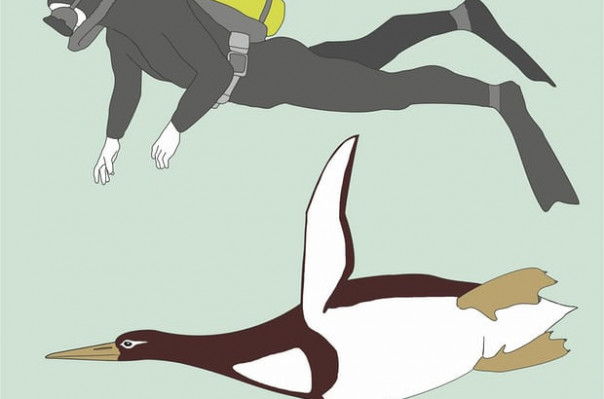The remnants of an ancient penguin that stood as tall as a human have been found encased in rock on a beach in New Zealand, The Guardian reports.
Fossil hunters chanced upon the prehistoric bones in sedimentary rock that formed 55m to 60m years ago on what is now Hampden beach in Otago in the country’s South Island.
Measurements of the partial skeleton show that the flightless bird weighed about 100kg and had a body length of 1.77 metres (5ft 10in), equal to the average height of an American man. Emperor penguins, the tallest penguin species alive today, reach only 1.2 metres when fully grown.
Penguins evolved from flying birds tens of millions of years ago, but lost the ability to get airborne and became accomplished swimmers instead. Once grounded, some penguin species became much larger, growing from about 80cm tall to twice the size.
The pieces of the latest skeleton, including wing, spine, breast and leg bones, were first discovered more than a decade ago, but the rock holding the fossilised bones was so hard that it has taken until now for researchers to prepare and study the remains.
Rather than the usual black-and-white colouring, the ancient penguin was probably brownish and had a longer beak than its modern-day cousins. “It would most likely have been slimmer too and not so cute looking,” said Gerald Mayr at the Senckenberg Research Institute and Natural History Museum in Frankfurt. “It’s one of the tallest penguins that has ever been found.”
Researchers named the new species Kumimanu biceae, after the Maori words “kumi”, meaning a large mythological monster, and “manu” for bird. The second part of the name honours Beatrice Tennyson, known as “Bice”, the mother of Alan Tennyson, a senior researcher on the team.
The fossilised remains of giant penguins have been found from 20m to 50m years ago, but older examples are extremely rare. The latest specimen, reported in Nature Communications, suggests that some penguins became giants soon after penguins first evolved and switched from flight to diving. At the time the newly discovered species was alive it would have shared the warm subtropical environment with other sea birds, turtles and sharks.
Giant penguins went extinct about 20m years ago ,when marine mammals arrived in the form of toothed whales, seals and other creatures. What spelled the end is unclear, but the big birds may have struggled to compete with marine mammals for food, or may have become the meal of choice for the new predators.
Another species of giant penguin, discovered in Antarctica in 2014, may have been even taller than Kumimanu biceae. Bones from the 37m-year-old “colossus penguin”, or Palaeeudyptes klekowskii, suggest the animal stretched two metres from beak to foot and weighed 115kg.












